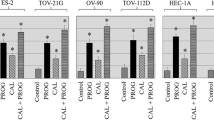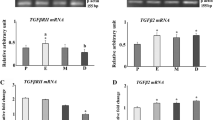Summary
The luminal epithelium of adult ovariectomized mice responds to estradiol-17β with a synchronised wave of DNA synthesis and mitosis. Estriol, however, although producing a similar DNA-synthetic and mitotic response fails to cause an increase in cell number owing to a wave of cell death occurring at mitosis. In the present study it was shown that cells died by two different routes. The majority died by apoptosis but, unusually, a minority also died by necrosis. In the apoptotic cells the cytoplasm became dense, the endoplasmic reticulum and nuclear cisternae dilated; chromatin became marginated the nucleus shrank and became deeply infolded and contorted. Apoptosis, however, was uncharacteristic in that the nucleus failed to fragment, form caps or show disruption before the cells died by membrane rupture. Furthermore, the cells were frequently lost in sheets from the epithelium into the lumen. Part of the biochemical explanation for this onset of cell death comes from the accelerated loss from the tissue of estriol when compared to estradiol-17β. This resulted in a decline in protein and rRNA biosynthesis and a failure to complete ribosomal maturation. Evidence in favour of this explanation came from experiments that showed a return to the estradiol-17β level of response and an inhibition of cell death when the occupancy of the estriol receptor was maintained.
Similar content being viewed by others
References
Beckingham-Smith K, Tata J (1976) Cell death. Are new proteins synthesised during hormone-induced tadpole tail regression? Exp Cell Res 100:129–146
Cheng SVY, MacDonald BS, Clark BF, Pollard JW (1985) Cell growth and cell proliferation may be dissociated in the mouse uterine luminal epithelium treated with female sex steroids. Exp Cell Res 160:459–470
Clark JH, Markaverich BM (1984) The agonistic and antiagonistic actions of estriol. J Steroid Biochem 20:1005–1013
Fagg B, Martin L, Rogers LA, Clark BF, Quarmby VE (1979) A simple method for removing the luminal epithelium of the mouse uterus for biochemical studies. J Reprod Fertil 57:335–339
Grunert G, Porcia M, Tchernitchin AN (1986) Differential potency of oestradiol-17β and diethylstilboestrol on separate groups of responses in the rat uterus. J Endocrinol 110:103–114
Harris J, Gorski J (1978) Evidence for a discontinuous requiement for estrogen in stimulation of deoxyribonucleic acid synthesis in the immature rat uterus. Endocrinology 103:240–245
Jordan EG (1984) Nucleolar nomenclature. J Cell Sci 67:217–220
Jordan EG, McGovern JH (1981) The quantitative relationship of the fibrillar centres and other nucleolar components to changes in growth conditions, serum deprivation and low doses of actinomycin D in cultured diploid human fibroblasts (Strain MRC-5). J Cell Sci 52:373–389
Kerr JFR (1971) Shrinkage necrosis: a distinct mode of cellular death. J Pathol 105:13–20
Kerr JFR, Wyllie AH, Currie AR (1972) Apoptosis: a basic biological phenomenon with wide ranging implications in tissue kinetics. Br J Cancer 26:239–257
Leroy F, Bogaert C, Van Hoeck J (1976) Stimulation of cell division in the endometrial epithelium of the rat by uterine distention. J Endocrinol 70:517–518
Martin L (1980) Effect of anti-estrogens on cell proliferation in the rodent reproductive tract. In: McLacklan JA (ed) Estrogens in the Environment. Eisevier, New York, p 103–130
Martin L, Finn CA (1968) Hormonal regulation of cell division in epithelial and connective tissues of the mouse uterus. J Endocrinol 41:363–371
Martin L, Finn CA (1970) Interactions of oestradiol and progestins in the mouse uterus. J Endocrinol 48:109–115
Martin L, Finn CA, Trinder G (1973) Hypertrophy and hyperplasia in the mouse uterus after oestrogen treatment: an autoradiographic study. J Endocrinol 56:133–144
Martin L, Pollard JW, Fagg B (1976) Oestriol, oestradiol-17β and the proliferation and death of uterine cells. J Endocrinol 69:103–115
Morgan CJ, Pollard JW, Stanley ER (1986) A macrophage cell line, BAC-1:2F5, specifically dependent on colon stimulating factor 1. J Cell Physiol 130:420–427
Nilsson O (1959) Ultrastructure of mouse uterine surface epithelium under different estrogenic influences. 6. Changes of some cell components. J Ultrastruct Res 2:373–387
Pollard JW (1975) Studies on protein and RNA synthesis in the mouse uterus. Ph.D. thesis London University, UK
Pollard JW, Martin L (1975) Cytoplasmic and nuclear non-histone proteins and mouse uterine cell proliferation. Mol Cell Endocrinol 2:183–191
Pollard JW, Lam T, Stanners CP (1980) Mammalian cells do not have a stringent response. J Cell Physiol 105:313–325
Reynolds ES (1963) The use of lead citrate at high pH as an electron-opaque stain in electron microscopy. J Cell Biol 17:208–212
Sandow BA, West NB, Norman RL, Brenner RM (1979) Hormonal control of apoptosis in hamster uterine luminal epithelium. Am J Anat 156:15–36
Saunders JW Jr (1966) Death in embryonic systems. Science 154:604–612
Stanners CP, Adams ME, Harkins JL, Pollard JW (1979) Transformed cells have lost control of ribosome number through their growth cycle. J Cell Physiol 100:127–138
Tushinski RJ, Oliver IT, Gilbert LJ, Tynan PW, Warner JR, Stanley ER (1982) Survival of mononuclear phagocytes depends on a lineage-specific growth factor that the differentiated cells selectively destroy. Cell 28:71–81
Williams T, Rogers AW (1980) Morphometric studies of the response of the luminal epithelium in the rat uterus to exogenous hormones. J Anat 130:867–881
Wyllie AH (1981) Cell death: a new classification separating apoptosis from necrosis. In: Bowen ID, Lockshin RA (eds) Cell Death in Biology and Pathology, Chapman and Hall, London New York, pp 9–34
Wyllie AH, Kerr JFR, Currie AR (1980) Cell death: the significance of apoptosis. Int Rev Cytol 68:251–306
Wyllie AH, Morris RG, Smith AL, Dunlop D (1984) Chromatin cleavage in apoptosis: association with condensed chromatin morphology and dependence on macromolecular synthesis. J Pathol 142:67–77
Author information
Authors and Affiliations
Rights and permissions
About this article
Cite this article
Pollard, J.W., Pacey, J., Cheng, S.V.Y. et al. Estrogens and cell death in murine uterine luminal epithelium. Cell Tissue Res. 249, 533–540 (1987). https://doi.org/10.1007/BF00217324
Accepted:
Issue Date:
DOI: https://doi.org/10.1007/BF00217324




